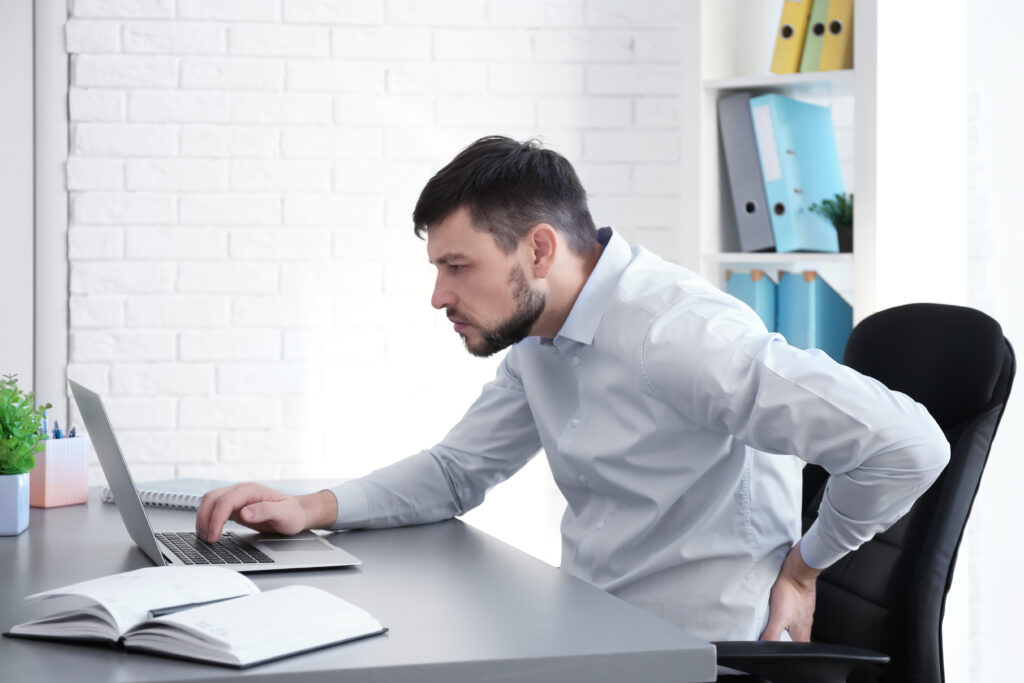You might be surprised to learn that back pain in Eagle, ID, stems from a variety of everyday activities and habits. From muscle strains due to physical exertion to the toll of poor posture during long hours of sitting, many factors contribute to your discomfort. Conditions like herniated discs and even emotional stress can further complicate matters. Fortunately, understanding these causes is the first step toward relief. But what local treatment options can effectively address these issues? Let's explore the possibilities.
Common Causes of Back Pain
When it comes to back pain, several common culprits can be at play. You might experience discomfort due to muscle strains, which often occur from overexertion or awkward movements. This strain can lead to inflammation and tightness in your back muscles, making everyday activities challenging.
Another frequent cause is poor posture. If you spend long hours sitting at a desk or slouching while using your phone, your spine can become misaligned, resulting in tension and pain. You may not even realize how your posture affects your back until it starts to hurt.
In addition to muscle strain and poor posture, herniated discs can be a significant source of pain. When the soft material inside a spinal disc bulges or leaks, it can press on nearby nerves, causing sharp or radiating pain. If you're experiencing numbness or tingling down your legs, a herniated disc might be the reason.
Osteoarthritis is another common issue, particularly as you age. This degenerative joint disease can wear down the cartilage in your spine, leading to stiffness and chronic pain. Activities that involve repetitive motion or heavy lifting can exacerbate these symptoms, leaving you feeling uncomfortable.
Lastly, emotional stress can also manifest physically. Anxiety and stress can cause muscle tension, which might contribute to your back pain.
Recognizing these common causes can help you take proactive steps to alleviate your discomfort and improve your overall well-being.
Local Treatment Options
Finding effective treatment options for back pain in Eagle, ID, can make a significant difference in your recovery. You've got several local resources at your fingertips that can help alleviate your discomfort and get you back to your daily activities.
First, consider visiting a chiropractor. They specialize in spinal manipulation and can help realign your spine, relieving pressure on affected nerves. Many patients find immediate relief after just a few sessions.
You can also look into acupuncture, a traditional Chinese medicine practice that uses thin needles to stimulate specific points on the body. Studies suggest it may be effective for managing chronic back pain.
If you're interested in a more hands-on approach, massage therapy is another local option worth exploring. A skilled massage therapist can target tight muscles and improve circulation, which might ease your pain and enhance your mobility.
You might also want to check out local wellness centers that offer a combination of treatments, including yoga and pilates classes. These classes focus on strengthening your core and improving flexibility, which can help prevent future back issues.
Lastly, don't forget about over-the-counter medications available at local pharmacies. Nonsteroidal anti-inflammatory drugs (NSAIDs) like ibuprofen can provide temporary relief from pain and swelling.
Benefits of Physical Therapy
Physical therapy offers a range of benefits for those suffering from back pain in Eagle, ID. One major advantage is the personalized treatment plan tailored to your specific needs. A physical therapist will assess your condition and design exercises that target your pain areas, improving your strength and flexibility. You'll find that this customized approach can lead to faster recovery.
Another benefit is the emphasis on hands-on techniques, such as manual therapy, which can alleviate pain and improve mobility. These techniques help break down scar tissue and improve circulation, promoting healing. You'll also learn various stretches and exercises that you can do at home, empowering you to take an active role in your recovery.
Physical therapy can also help you understand the underlying causes of your back pain. By educating yourself about your body mechanics and posture, you'll gain insights that can prevent future issues. Plus, many therapists incorporate modalities like heat, ice, or electrical stimulation, which can further enhance pain relief.
Moreover, physical therapy can reduce your reliance on pain medications, minimizing potential side effects. As you progress, you'll likely notice improvements not just in your back pain, but in your overall physical fitness and well-being.
With consistent therapy sessions, you'll build confidence in your movement, enabling you to return to daily activities and hobbies you enjoy. In short, physical therapy is a valuable tool for reclaiming your life from back pain.
Importance of Proper Posture
Your posture plays an essential role in your overall back health. Poor posture can lead to discomfort and long-term issues, but an ergonomic workspace and specific exercises can help you improve it.
Let's explore how making small changes can make a big difference in your daily life.
Effects of Poor Posture
Poor posture can have significant repercussions on your overall health, particularly when it comes to back pain. When you slouch or sit awkwardly, you're placing undue stress on your spine and surrounding muscles. This strain can lead to chronic discomfort, making everyday activities feel like a chore. You mightn't realize it at first, but those long hours hunched over your computer or phone can take a toll on your back.
Additionally, poor posture can affect your body's alignment, leading to muscle imbalances. Over time, these imbalances can cause tightness in some muscles while weakening others, further exacerbating your back pain. You may also notice that your energy levels drop; when your body isn't aligned properly, it takes more effort to maintain basic movements, leaving you fatigued.
Moreover, poor posture can impact your mental well-being. Studies show that slouching can lead to feelings of low confidence and increased stress.
Ergonomic Workspace Setup
An ergonomic workspace setup is essential for maintaining proper posture and preventing back pain. When you spend long hours at your desk, the way you arrange your workspace can make a significant difference.
Start by ensuring your chair supports your lower back and allows your feet to rest flat on the floor. If your chair isn't adjustable, consider a footrest to help you maintain that proper alignment.
Next, position your computer monitor at eye level. This way, you'll avoid straining your neck by looking down or craning it upward. Your keyboard should also be within easy reach, allowing your elbows to stay close to your body and bent at a 90-degree angle. This reduces the risk of strain in your arms and shoulders.
Don't forget to keep your workstation clutter-free. A tidy workspace minimizes distractions and encourages you to maintain a proper posture instead of slouching.
Finally, remember to take breaks. Standing up and stretching periodically can help reset your posture and relieve any tension that may have built up.
Exercises for Posture Improvement
Maintaining proper posture goes hand in hand with a well-organized workspace, but it doesn't stop there. To truly improve your posture, incorporating specific exercises into your routine is essential. These exercises not only strengthen your muscles but also promote awareness of your body's alignment.
Start with wall angels. Stand with your back against a wall, arms raised at a 90-degree angle. Slide your arms up and down while keeping your back flat against the wall. This exercise helps open up your chest and strengthen your shoulder muscles.
Next, try planks. Position your body in a straight line from head to heels, resting on your forearms and toes. Engage your core and hold for 30 seconds. Planks build core strength, which is vital for maintaining good posture.
Lastly, don't forget about stretches. Perform neck stretches by tilting your head to one side and holding for 15 seconds on each side. This relieves tension and encourages better alignment.
Lifestyle Changes for Relief
While you may not realize it, small lifestyle changes can greatly alleviate back pain. One of the first adjustments you can make is to improve your sitting habits. Choose ergonomic furniture that supports your back and encourages good posture. If you're sitting for long periods, take breaks every hour to stand, stretch, or walk around. This simple act can reduce stiffness and discomfort.
Another important change involves your sleeping environment. Invest in a quality mattress that provides adequate support. A mattress that's too soft can cause your spine to misalign, leading to pain.
Also, try sleeping on your side with a pillow between your knees to maintain proper spinal alignment.
Incorporating regular physical activity into your routine is essential. Aim for low-impact exercises like walking, swimming, or yoga. These activities strengthen your core muscles, which play a significant role in supporting your back.
Additionally, stay hydrated and maintain a balanced diet. Proper nutrition helps keep your muscles and joints healthy, reducing the risk of back pain.
Finally, manage your stress levels. Stress can lead to muscle tension, which may exacerbate pain. Practices like meditation, deep breathing, or even simple hobbies can help you unwind.
Community Support Resources
In Eagle, ID, you'll find valuable community support resources that can aid your back pain journey.
Local support groups offer a chance to connect with others facing similar challenges, while wellness workshops provide practical tools and strategies for relief.
Engaging with these resources can make a significant difference in your recovery and overall well-being.
Local Support Groups
Finding support in your community can make a significant difference when dealing with back pain. Local support groups offer a space where you can share your experiences, gain advice, and connect with others facing similar challenges. These groups create a sense of belonging, helping you realize you're not alone in your struggle.
In Eagle, ID, you can find various support groups specifically aimed at those dealing with back pain. Joining one of these groups can provide you with valuable insights into coping mechanisms, pain management strategies, and even local resources that can help improve your quality of life.
You'll hear firsthand accounts of what's worked for others and may discover new techniques to alleviate your discomfort.
Moreover, support groups often host guest speakers, including healthcare professionals who can provide expert advice and answer your questions. Engaging in discussions can boost your morale and encourage you to stay proactive in your healing journey.
Wellness Workshops Available
Wellness workshops are often available in Eagle, ID, providing valuable resources for those dealing with back pain. These workshops focus on education, prevention, and management strategies that can help you take control of your discomfort.
You'll find sessions led by experienced professionals who understand the nuances of back pain and its impact on daily life. In these workshops, you'll learn about proper posture, effective stretching exercises, and ergonomic practices that can reduce strain on your back.
Participants often share their experiences, creating a supportive environment where you can connect with others facing similar challenges. Additionally, workshops may cover topics like nutrition, stress management, and mindfulness techniques, all of which can contribute to your overall well-being.
Conclusion
In Eagle, ID, understanding the common causes of back pain can empower you to seek effective relief. By exploring local treatment options like chiropractic care and physical therapy, you can find the support you need. Prioritizing proper posture and making lifestyle changes can further enhance your recovery. Remember, you're not alone in this journey—community resources are available to help you manage and overcome back pain for a healthier, more active life.



